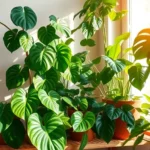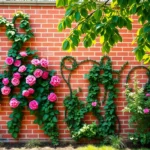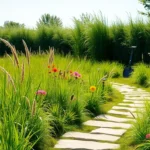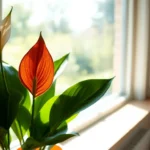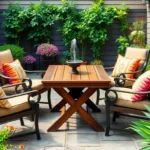Garden borders transform ordinary landscapes into stunning outdoor masterpieces that’ll make your neighbors stop and stare. Whether you’re working with a sprawling backyard or a cozy corner space we’ve all dreamed of creating those picture-perfect edges that define and elevate our gardens.
The right border design doesn’t just contain your plants – it creates visual flow guides the eye and adds that professional landscaping touch you’ve been craving. From classic brick edging to creative recycled materials we’re about to explore border ideas that fit every budget style and skill level.
Ready to turn your garden from basic to breathtaking? We’ll walk you through proven border techniques that industry designers use to create those magazine-worthy gardens. These aren’t just pretty additions – they’re practical answers that’ll reduce maintenance time while maximizing your garden’s visual impact.
Create Defined Edges With Classic Brick Borders
Brick borders bring timeless elegance to garden edges while providing long-lasting durability that withstands seasonal changes. We’ve found that classic brick edging creates clean lines that complement both traditional and modern industry designs.
Traditional Red Brick Layout Patterns
Running bond patterns create the most popular brick border design, where each brick offsets the next by half its length. We recommend this classic arrangement for straight garden edges because it provides excellent structural stability and visual continuity. Herringbone patterns offer ever-changing visual interest by arranging bricks at alternating 45-degree angles, creating a zigzag effect that works beautifully along curved borders. Stacked bond layouts position bricks directly on top of each other in perfect alignment, producing a more formal appearance that suits geometric garden designs.
Stack running patterns two bricks deep when you need wider borders that can handle heavier foot traffic or equipment. We suggest using soldier courses, where bricks stand upright on their narrow edge, to create distinctive vertical lines that add height variation to flat borders. Basketweave patterns alternate horizontal and vertical brick pairs to form square sections that create texture and visual depth along garden perimeters.
Recycled Brick For Rustic Charm
Salvaged bricks from old buildings bring character and environmental benefits to garden borders while reducing construction waste. We’ve discovered that reclaimed bricks often feature unique weathering patterns, color variations, and surface textures that new bricks can’t replicate. Antique bricks typically cost 30-50% less than new materials while providing authentic vintage appeal that complements cottage gardens and farmhouse landscapes.
Weathered surfaces on recycled bricks create natural grip that prevents slipping when used as pathway edging. We find that mixed brick colors from different sources produce organic color gradients that blend seamlessly with natural garden settings. Chimneys, sidewalks, and demolished structures provide excellent sources for quality recycled bricks that maintain structural integrity for border applications.
Check recycled bricks for cracks, chips, or excessive mortar residue before installation to ensure long term performance. We recommend cleaning salvaged bricks with wire brushes and mild detergent to remove debris while preserving their authentic patina.
Mortared Vs. Dry-Laid Installation Methods
| Installation Method | Cost Range | Installation Time | Permanence | Maintenance Required |
|---|---|---|---|---|
| Dry-laid | $3-5 per linear foot | 2-4 hours per 20 feet | Moderate | Annual adjustment |
| Mortared | $8-12 per linear foot | 4-6 hours per 20 feet | Permanent | Minimal |
Dry-laid installation allows bricks to rest directly on leveled sand or gravel base without cement bonding. We prefer this method for DIY projects because it requires fewer specialized tools and permits easy adjustments or repairs later. Frost heave can shift dry-laid borders over time, requiring periodic releveling in colder climates.
Mortared borders use cement-based adhesive to permanently bond bricks together and to concrete foundations. We recommend mortared installation for high traffic areas, steep slopes, or locations where precise alignment is critical. Professional installation typically becomes necessary for mortared borders due to mixing requirements, proper curing techniques, and foundation preparation.
Sand setting beds work best for dry-laid borders when combined with industry fabric to prevent weed growth beneath the bricks. We suggest adding polymeric sand between joints in dry-laid installations to lock bricks in place while maintaining flexibility for seasonal ground movement.
Design Natural Stone Garden Borders
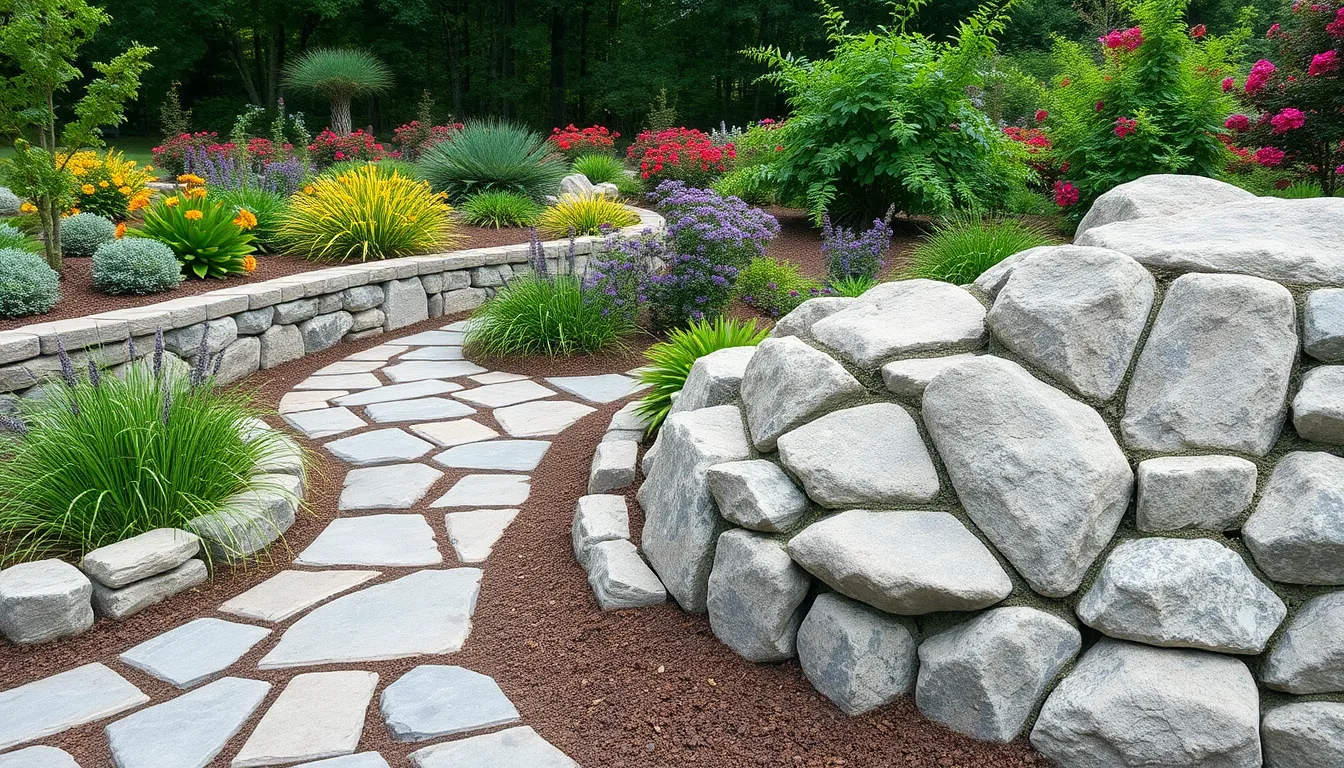
Natural stone borders offer unmatched versatility and lasting beauty that complements any garden style. We’ll explore three popular stone options that create stunning borders while addressing different design needs and industry challenges.
Fieldstone For Organic Appeal
Fieldstone creates the most natural looking garden borders we can achieve in landscaping design. These irregularly shaped stones blend seamlessly with surrounding vegetation and provide an authentic rustic charm that appears weathered by time. We recommend using fieldstone in informal garden settings where you want borders that look like they’ve existed for decades.
Various shapes and sizes of fieldstone allow us to create borders with organic flowing lines that follow natural contours. Stacking fieldstone pieces creates depth and visual interest while maintaining the unstructured appearance that makes this material so appealing. We find fieldstone works exceptionally well around cottage gardens, wildflower beds, and naturalized landscapes where formal structure would feel out of place.
Cut Stone For Formal Garden Settings
Cut stone borders deliver the clean structured lines that formal gardens require for elegance and sophistication. We use precisely shaped stones like granite, limestone, and marble to create borders with sharp edges and uniform appearance. These materials provide the architectural quality that enhances formal garden designs and creates visual continuity with structured industry elements.
Granite cut stone offers exceptional durability and comes in various colors from light gray to deep charcoal. Limestone provides a softer appearance with warm tones that complement traditional garden styles. Marble creates the most luxurious look but requires more maintenance in outdoor settings. We recommend cut stone for geometric garden beds, formal walkways, and areas where precision and permanence are priorities.
River Rock Borders For Curved Landscapes
River rock borders excel in curved industry designs where we need materials that flow naturally around bends and irregular shapes. These smooth rounded stones create beautiful contrast against angular garden elements and provide visual softness that complements winding paths and organic garden layouts. We use river rocks to define different garden zones while maintaining natural movement throughout the design.
Winding paths benefit significantly from river rock borders because these stones follow curves without creating awkward joints or gaps. The smooth texture of river rocks also provides safety advantages in high traffic areas where sharp edges could pose hazards. We find river rock borders work particularly well around water features, curved flower beds, and transitional areas between different garden sections.
Install Low-Maintenance Concrete Edging
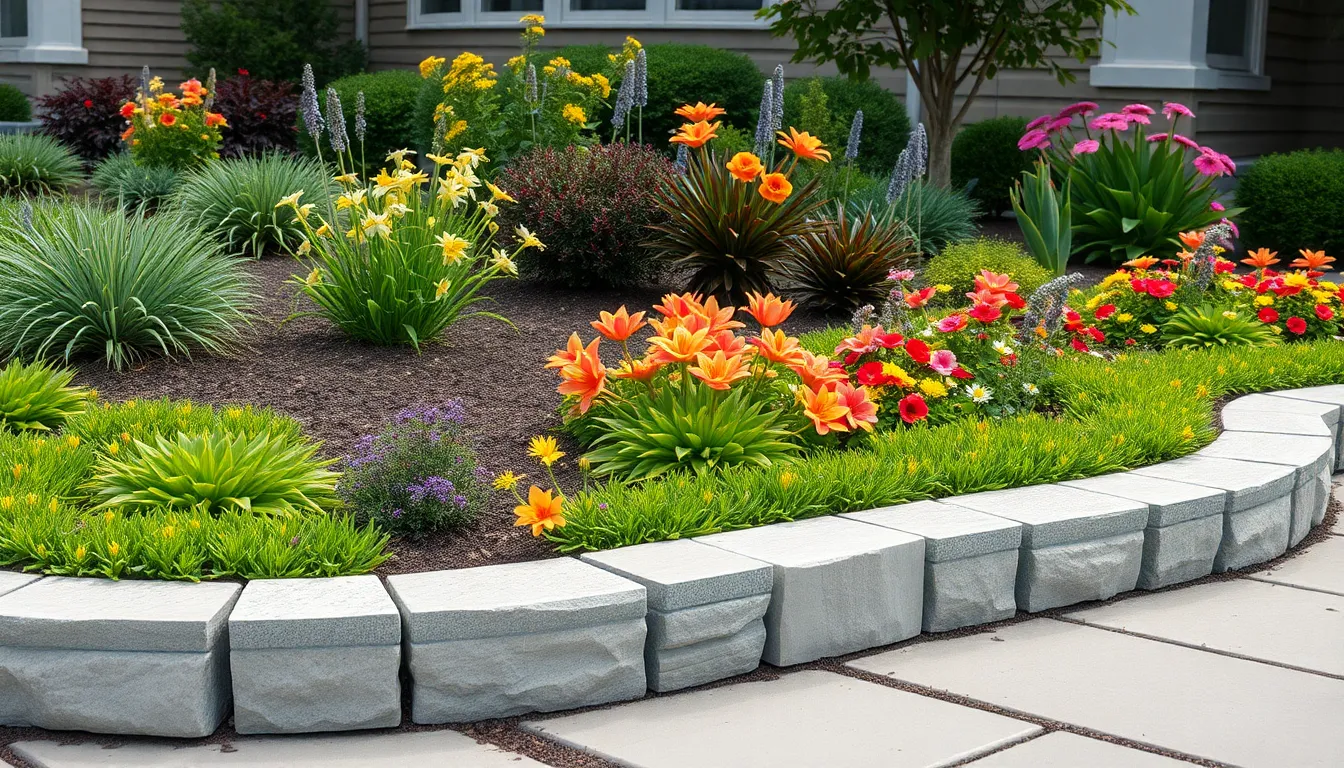
Concrete edging delivers unmatched durability while requiring minimal upkeep compared to organic border materials. We’ve found that concrete borders resist rot, warping, and frequent replacement needs that plague wooden alternatives.
Poured Concrete Border Benefits
Poured concrete borders offer complete customization for any garden shape or size requirement. Creating seamless curves and sharp angles becomes effortless when you pour concrete directly into custom forms. Once cured, this edging method provides exceptional sturdiness that withstands lawn equipment impact and harsh weather conditions year after year.
Installation involves forming the desired shape, pouring the concrete mixture, and finishing the surface to achieve either smooth or textured appearances. Flexibility in design allows us to create borders that follow natural garden contours or architectural lines perfectly. The integrated look eliminates gaps and joints that typically collect debris in segmented edging systems.
Decorative Stamped Concrete Options
Stamped concrete transforms basic borders into stunning design features that mimic expensive materials at lower costs. Patterns resembling natural stone, brick, or wood grain get pressed into wet concrete using specialized stamps and tools. This technique opens unlimited design possibilities to match any garden style from rustic to contemporary.
Stamping occurs while concrete remains workable, allowing artisans to create intricate textures and realistic material appearances. Maintenance stays minimal with occasional cleaning being the only regular requirement. Color options expand further when integral pigments or surface stains get applied during the stamping process.
Precast Concrete Blocks And Pavers
Precast concrete elements provide quick installation answers for gardeners seeking immediate results. These pre-formed blocks and pavers come in various shapes, sizes, and finishes that accommodate creative border designs without extensive construction time. Interlocking systems reduce shifting risks while simplifying the installation process for DIY enthusiasts.
| Installation Aspect | Precast Benefits |
|---|---|
| Installation Time | 50% faster than poured options |
| Maintenance | Weather and wear resistant |
| Design Variety | Decorative and plain styles available |
| Replacement | Individual pieces easily replaceable |
Both decorative and plain styles offer flexibility for different garden aesthetics while maintaining the low maintenance characteristics that make concrete edging appealing. Weather resistance and durability ensure these borders maintain their appearance with minimal intervention over many seasons.
Plant Living Borders With Ornamental Shrubs
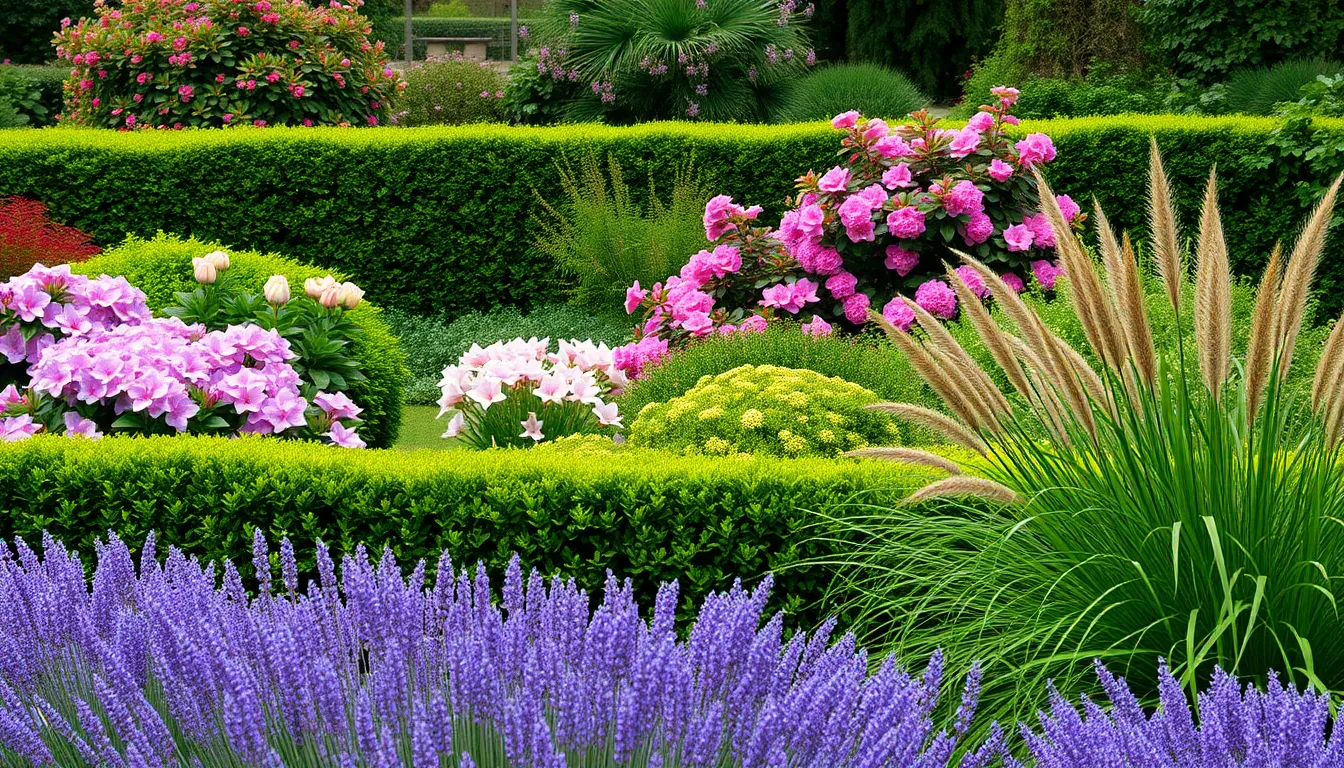
Living borders transform garden edges into vibrant, ever-changing features that evolve throughout the seasons. We’ve discovered that ornamental shrubs like hydrangea and rhododendron create lush borders that offer both structure and seasonal interest to any garden space.
Boxwood Hedges For Classic Formality
Boxwood hedges deliver unmatched elegance with their neat, structured appearance that defines formal garden design. We appreciate how these evergreen shrubs maintain their crisp lines year-round, creating timeless borders that complement traditional industry styles.
Regular pruning keeps boxwood hedges in perfect shape, typically requiring trimming twice per year during the growing season. We recommend spring and late summer pruning sessions to maintain the classic formal look that makes these borders so appealing.
Dense foliage creates privacy screens while establishing clear garden boundaries that separate different industry zones. We’ve found that boxwood varieties like English boxwood and Korean boxwood thrive in various climates, making them versatile choices for formal border applications.
Slow growth rates mean these hedges require patience but reward gardeners with decades of reliable performance. We suggest spacing plants 18 to 24 inches apart for solid hedge formation that fills in completely over time.
Lavender Borders For Fragrance And Color
Lavender borders combine aromatic appeal with stunning purple blooms that attract beneficial pollinators throughout the growing season. We love how these low-maintenance shrubs thrive in Mediterranean-style gardens while requiring minimal water once established.
Fragrant oils released from lavender foliage create natural aromatherapy experiences every time we brush against the plants. We’ve observed that varieties like English lavender and French lavender offer different bloom times, extending the flowering season from late spring through early fall.
Purple flower spikes provide consistent color that complements both cool and warm garden palettes. We recommend planting lavender in full sun locations with well-draining soil to maximize both fragrance production and bloom intensity.
Drought tolerance makes lavender borders perfect for water-wise landscaping in regions with limited rainfall. We suggest spacing plants 2 to 3 feet apart to allow proper air circulation that prevents fungal issues common in humid climates.
Ornamental Grasses For Modern Appeal
Ornamental grasses create sleek, contemporary borders that move gracefully in the breeze while providing year-round structural interest. We’ve discovered that these versatile plants come in various heights and textures, making them adaptable to different modern garden styles.
Fountain grass and maiden grass offer dramatic vertical elements that soften hard industry features like concrete patios and stone walls. We appreciate how these grasses provide privacy screening without the formal rigidity of traditional hedge materials.
Seasonal changes showcase different grass characteristics, from fresh spring growth to golden autumn seed heads that persist through winter. We recommend varieties like feather reed grass for upright borders and blue fescue for compact edging applications.
Low maintenance requirements make ornamental grass borders ideal for busy homeowners seeking stylish industry answers. We suggest annual cutting in late winter or early spring to make room for new growth while maintaining the clean lines that define modern garden aesthetics.
Build Raised Timber Garden Borders
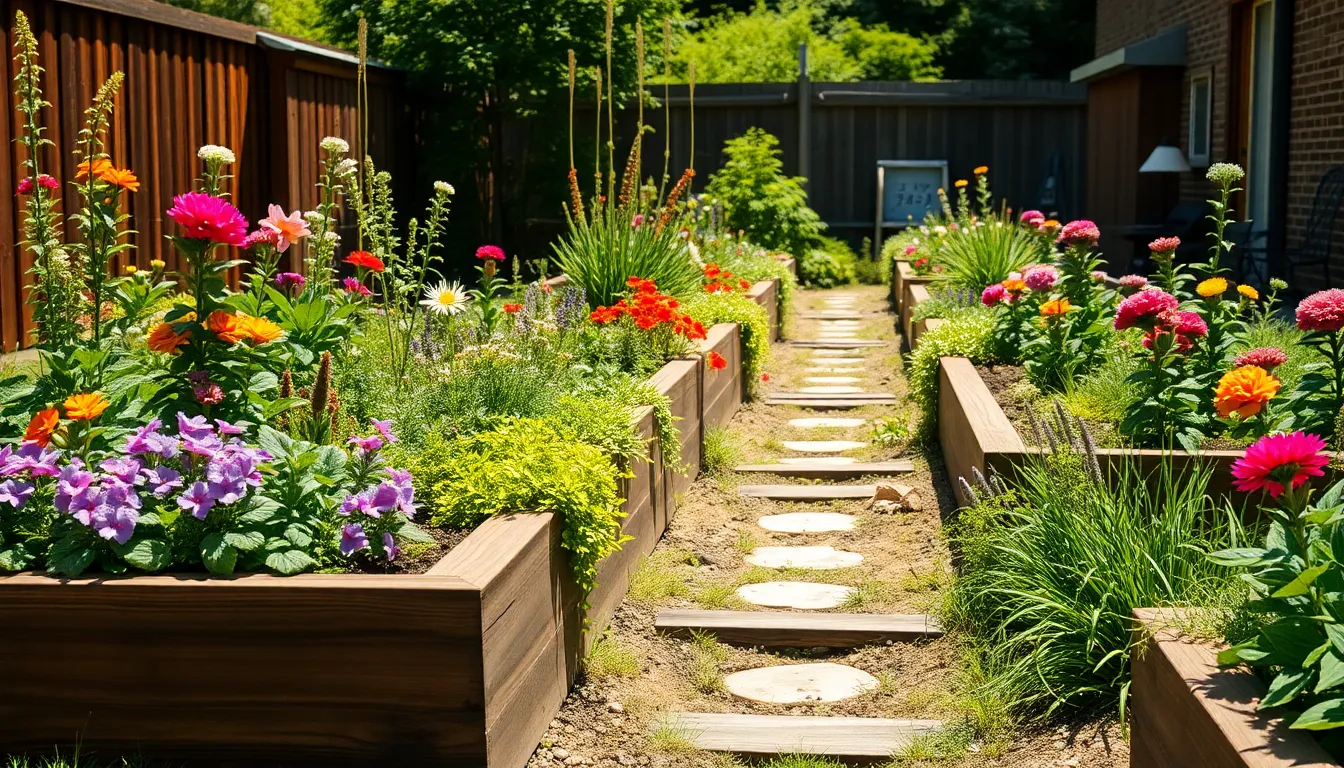
Timber borders create stunning vertical elements that define garden spaces with natural warmth and structure. These versatile borders work perfectly for both formal and casual industry designs.
Pressure-Treated Lumber Considerations
Durability makes pressure-treated lumber an attractive choice for long-lasting garden borders that withstand harsh weather conditions. Chemical treatments in this lumber can leach into surrounding soil over time, potentially affecting plant health and growth. We recommend using pressure-treated materials for ornamental borders rather than areas where you’ll grow edible plants.
Installation becomes straightforward with pressure-treated lumber since the material resists rot and insect damage naturally. Cost effectiveness appeals to many gardeners, as pressure-treated options typically cost less than natural wood alternatives. Environmental impact requires careful consideration since the chemical treatments may affect soil quality and beneficial organisms over extended periods.
Cedar And Redwood Natural Options
Cedar borders provide natural rot resistance without chemical treatments, making them perfect for organic gardens and edible plant areas. These woods develop beautiful weathered patinas over time, creating rustic charm that enhances any industry design. We find cedar particularly effective for raised vegetable beds since it won’t introduce harmful chemicals into the growing environment.
Redwood options offer superior durability and stunning natural grain patterns that complement both traditional and contemporary garden styles. Higher costs reflect the premium quality, but the investment pays off through decades of reliable performance. Both cedar and redwood resist insects naturally, eliminating the need for chemical treatments that could harm beneficial garden wildlife.
Maintenance remains minimal with these natural woods, requiring only occasional cleaning and optional protective finishes to maintain their appearance.
Railroad Ties For Rustic Garden Design
Railroad ties deliver authentic weathered character that instantly creates vintage appeal in garden borders and raised bed constructions. These massive timbers provide exceptional structural strength for large raised beds and terraced garden designs. We caution that older railroad ties may contain creosote and other preservatives that can harm plants and soil organisms.
Rustic aesthetics emerge naturally as these ties age and develop unique textures and color variations over seasons. Installation requires heavy equipment or multiple people due to the substantial weight of each tie. Chemical considerations make railroad ties unsuitable for vegetable gardens or areas where children and pets frequently play.
Design applications work best in informal garden settings where the industrial look complements cottage gardens, wildflower meadows, or rustic industry themes.
Incorporate Metal Edging Solutions
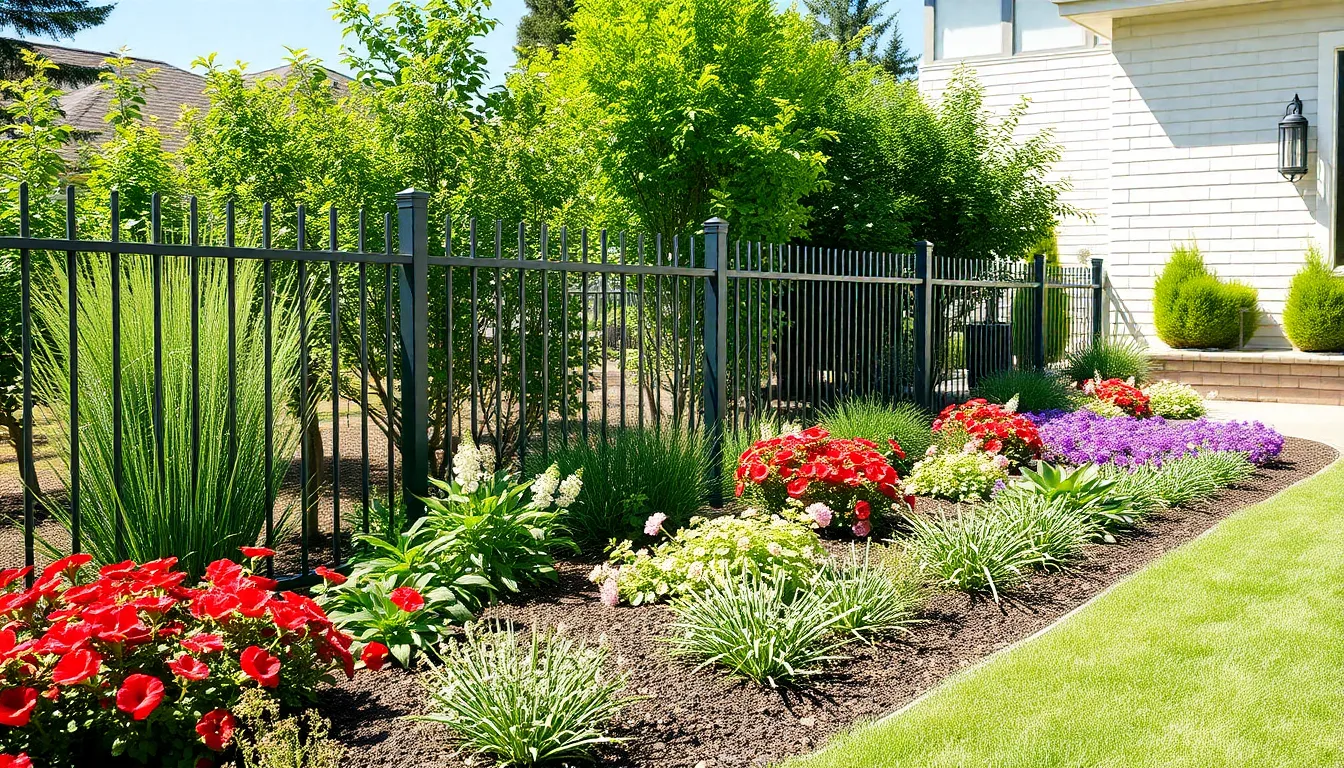
Metal garden borders deliver exceptional durability and contemporary appeal that transforms any outdoor space. We’ll explore three versatile metal options that create striking visual boundaries while requiring minimal maintenance compared to traditional materials.
Steel Edging For Clean Modern Lines
Steel edging creates sleek, modern borders that define garden spaces with precision and style. We recommend steel for homeowners seeking clean separation between lawn and garden areas, as it costs less than brick or stone while offering superior durability compared to plastic or rubber alternatives. The material’s thin profile makes installation straightforward, and it blends seamlessly with surrounding landscapes without overwhelming garden design.
Benefits include easy installation processes, long-lasting performance, and versatile application across different garden styles. Steel’s strength allows it to maintain straight edges over time, preventing grass encroachment and reducing maintenance needs. Most steel edging products come with protective coatings that resist rust and weathering for years of reliable service.
Aluminum Borders For Durability
Aluminum borders provide lightweight answers that resist corrosion and weather damage throughout all seasons. We favor aluminum for its exceptional versatility, as it shapes easily around curved garden beds and can be colored to match various design themes. The material’s natural resistance to rust eliminates concerns about staining or deterioration that affect other metal options.
Installation becomes simpler with aluminum’s manageable weight, making it ideal for DIY projects. Customization options include powder coating in multiple colors, allowing seamless integration with existing industry elements. Aluminum’s durability ensures decades of performance without replacement, making it a cost effective long term investment for garden borders.
Decorative Iron Fencing Elements
Decorative iron elements add elegant sophistication to garden borders through intricate patterns and stylish designs. We use iron fencing components to create stunning visual barriers that define pathways and separate garden sections with artistic flair. These elements come in various heights and ornamental styles, from simple geometric patterns to elaborate scrollwork that enhances any industry theme.
Iron’s strength allows for taller border applications that provide privacy and wind protection for delicate plants. Customizable designs enable homeowners to match existing architectural features or create unique focal points throughout the garden. Proper coating and maintenance ensure iron elements maintain their beauty and structural integrity for generations of garden enjoyment.
Design Mulch And Gravel Borders
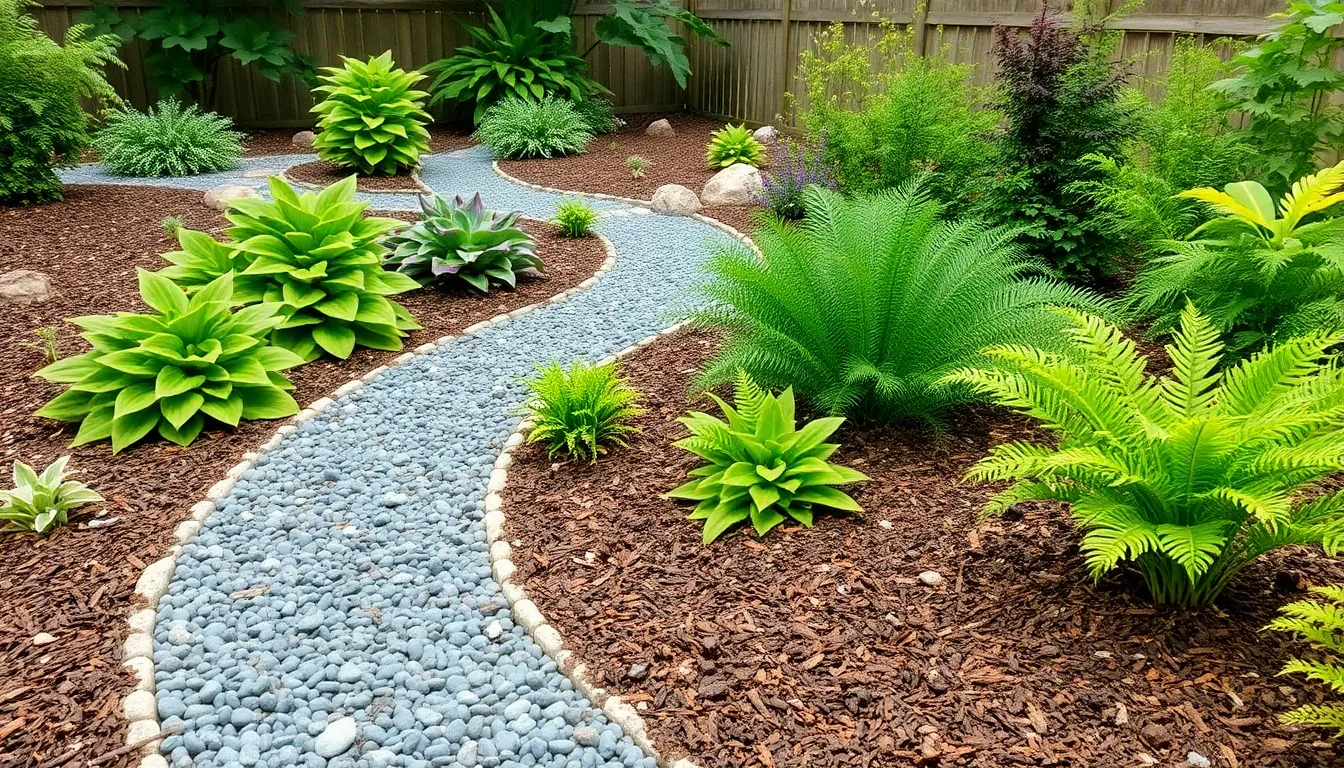
Moving beyond permanent structural borders, loose materials offer flexible design possibilities that complement any garden style. These adaptable options create beautiful transitions while providing practical benefits for plant health and garden maintenance.
Organic Mulch Border Applications
Wood chips create rustic pathways that blend naturally with wooded landscapes and cottage gardens. We recommend maintaining a 2 to 3 inch depth around plant bases to retain moisture without trapping excess water that could harm roots. Bark mulch works particularly well in shaded areas where its rich brown tones complement hostas and ferns.
Shredded leaves provide an economical border solution that enriches soil as they decompose naturally. Garden beds benefit from this organic matter, which improves drainage while suppressing weeds effectively. Plant selection becomes crucial when using leaf mulch, as some varieties prefer the slightly acidic conditions that decomposing leaves create.
Composted materials offer nutrient rich borders that feed plants throughout the growing season. We apply a base layer of quality compost before adding decorative mulch on top for enhanced soil health. This layering technique works exceptionally well around perennial borders and vegetable gardens.
Decorative Gravel Color Combinations
White and gray combinations create sophisticated borders that highlight colorful plantings without overwhelming delicate flowers. River rocks in these neutral tones work beautifully with modern architecture and contemporary industry designs. We mix different sizes to add visual texture while maintaining a cohesive color palette.
Beige and tan gravel complements natural stone hardscaping and earth tone color schemes throughout the garden. These warm colors blend seamlessly with sandstone patios and clay brick pathways. Small pea gravel mixed with larger decorative stones creates depth and prevents the monotonous appearance of single size materials.
Contrasting color patterns make dramatic statements when different gravel types create geometric designs or flowing curves. Metal edging helps maintain clean separation lines between different colored sections. We recommend using no more than three colors to avoid overwhelming the overall garden aesthetic.
Maintenance Tips For Loose Material Borders
Regular raking keeps mulch and gravel evenly distributed while preventing unsightly clumping or bare spots. We recommend monthly maintenance during growing season to maintain professional appearance. Organic mulches require more frequent attention as they settle and decompose naturally.
Annual replenishment ensures adequate depth and fresh appearance for organic mulch borders. Most wood based mulches need 1 to 2 inches added each spring as previous layers decompose into soil. Gravel borders typically require minimal replacement unless materials migrate due to heavy rainfall or foot traffic.
Debris removal maintains the clean appearance that makes loose material borders so attractive. Leaf blowers work efficiently for clearing gravel surfaces, while gentle raking prevents damage to underlying weed barrier fabric. We suggest installing proper edging materials like metal strips or plastic barriers to contain loose materials and reduce maintenance requirements significantly.
Create Multi-Level Terraced Borders
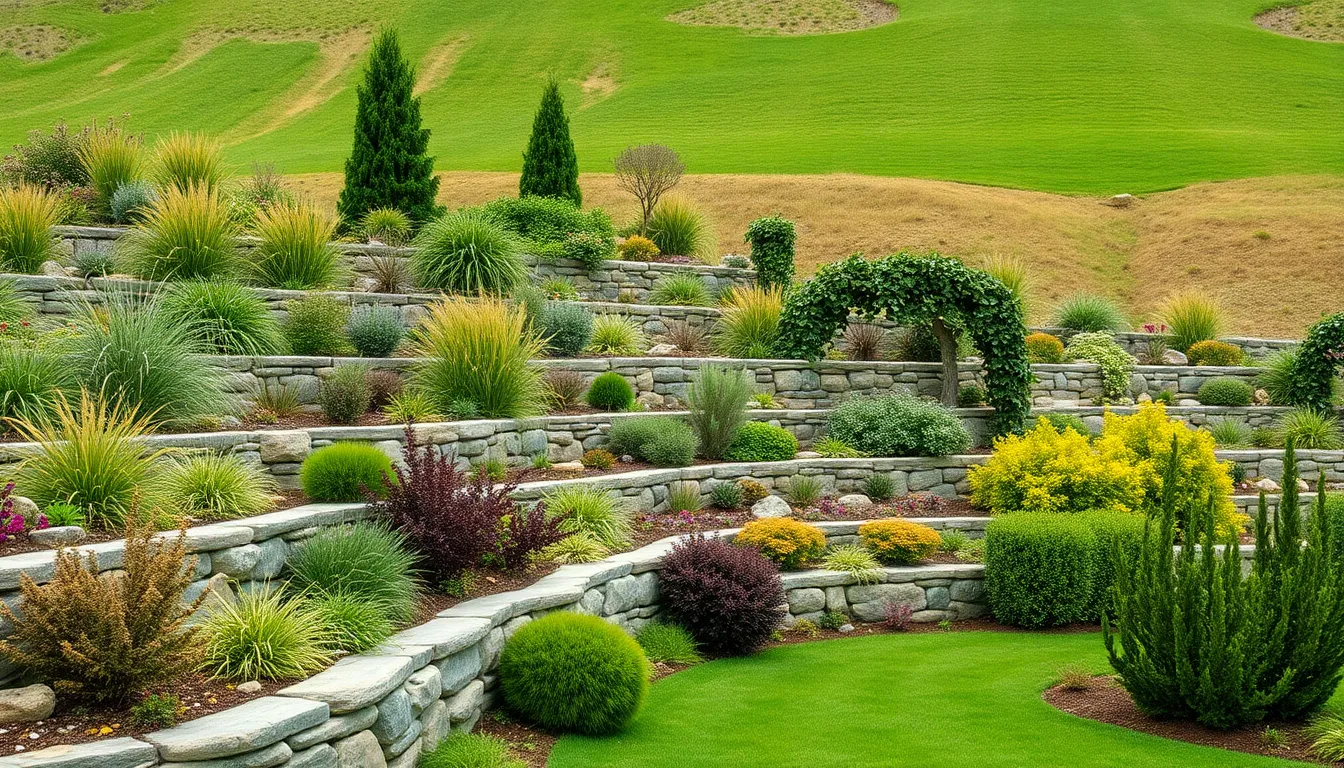
Terraced garden borders transform challenging slopes into functional multi-level landscapes that maximize planting space while preventing soil erosion. We’ll explore proven techniques for creating stunning terraced designs that work seamlessly with your property’s natural contours.
Retaining Wall Integration Techniques
Stone materials form the foundation of durable terraced borders, with options including fieldstone, brick, and gabion baskets that provide both structural support and visual appeal. Brick retaining walls offer classic elegance while maintaining the soil stability essential for multi-level designs. Gabion baskets filled with natural stone create modern industrial aesthetics while allowing excellent drainage through their wire mesh construction.
Design integration connects different terrace levels through matching materials that create visual continuity throughout your garden space. Steps and walkways should incorporate the same materials as your retaining walls to help easy movement between levels. Visual flow improves dramatically when you match wall materials with adjacent hardscaping elements like patios or garden paths.
Drainage systems prevent water damage and soil erosion that can compromise your terraced border structure over time. French drains installed behind retaining walls channel excess water away from the wall foundation. Proper drainage extends the lifespan of your terraced borders while protecting your plant investments from waterlogged conditions.
Sloped Garden Border Answers
Terracing techniques have stabilized slopes for thousands of years by cutting flat planting areas into hillsides to prevent erosion. Ancient methods prove their effectiveness in modern garden applications where slopes challenge traditional border installation. Soil stabilization occurs naturally when you create level planting areas that interrupt water flow down steep inclines.
Pressure treated sleepers offer affordable answers for shallow slopes while providing natural wood aesthetics that complement organic garden designs. Railway sleeper alternatives avoid potential health risks associated with old treated lumber while maintaining the rustic appearance many gardeners prefer. Natural materials like cedar or redwood sleepers resist rot without chemical treatments that could affect plant health.
Light condition variations across terraced levels require careful consideration since upper terraces receive more sunlight than lower shaded areas. Microclimate differences develop at each level due to varying sun exposure, wind patterns, and moisture retention. Strategic planning accounts for these environmental changes when selecting plants for different terrace levels.
Plant Selection For Terraced Designs
Ornamental grasses add texture and movement to terraced gardens while requiring minimal maintenance once established in their designated levels. Fountain grass varieties like Pennisetum create dramatic focal points on upper terraces where their graceful movement catches attention. Feather reed grass provides vertical structure that complements the horizontal lines of retaining walls.
Climbing vines transform plain retaining walls into living art installations while maximizing vertical growing space in terraced designs. Clematis varieties offer seasonal color changes that keep terraced borders interesting throughout the growing season. English ivy provides evergreen coverage for retaining walls while requiring minimal care once established.
Compact shrubs anchor terraced plantings with permanent structure that looks attractive year round regardless of seasonal changes. Dwarf conifers maintain their shape without frequent pruning while providing evergreen interest at each terrace level. Boxwood varieties create formal hedge elements that emphasize the geometric nature of terraced garden borders.
Add Decorative Elements To Garden Borders
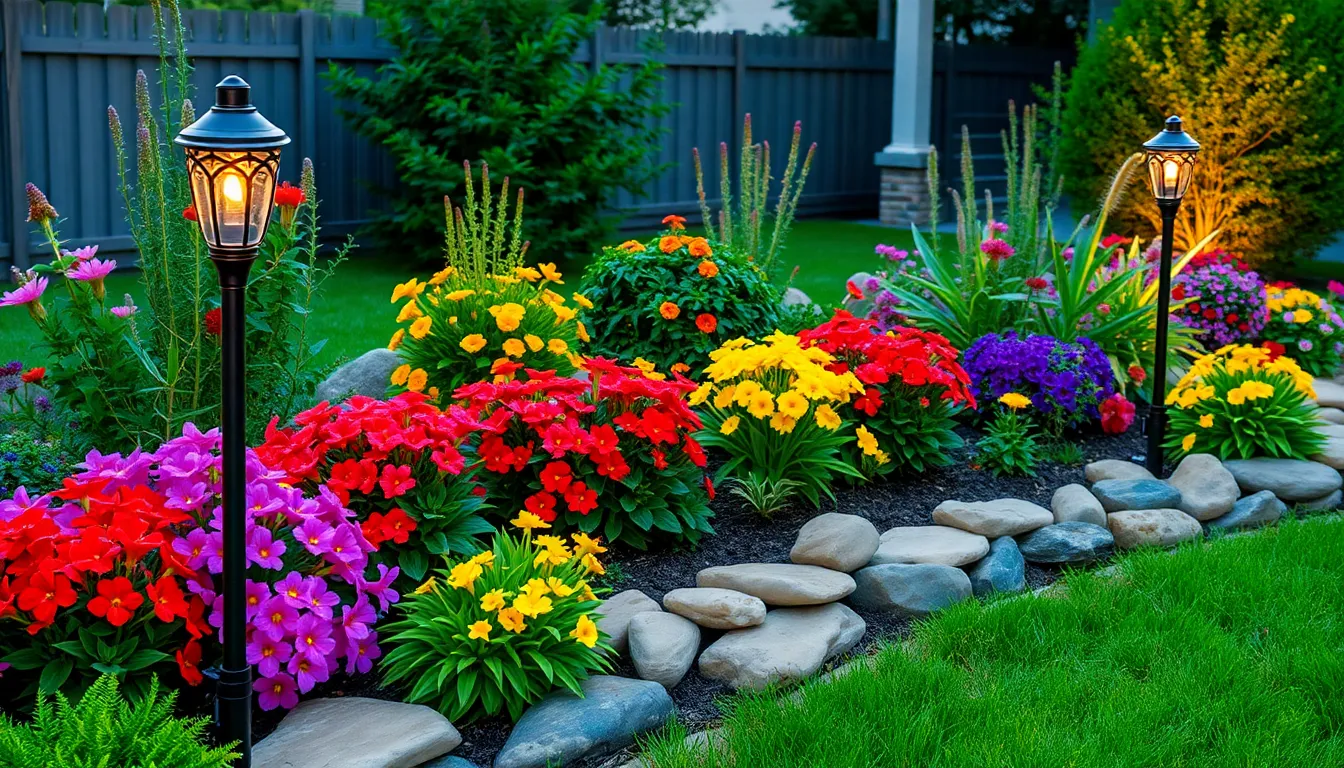
We can transform ordinary garden borders into stunning focal points by incorporating carefully chosen decorative elements. These additions not only enhance visual appeal but also provide functional benefits that elevate our overall industry design.
Solar Lighting Border Integration
Solar lights create beautiful nighttime ambiance while maintaining eco-friendly garden practices. Installation requires no electrical wiring, making them perfect for DIY enthusiasts who want professional results without complicated setup processes.
We recommend placing solar path lights every 6-8 feet along border edges to create consistent illumination patterns. Battery life typically lasts 8-10 hours after full daylight charging, providing reliable lighting throughout evening hours.
Modern solar options include stake lights, string lights, and decorative lanterns that complement various garden styles. Weatherproof designs withstand seasonal changes while requiring minimal maintenance beyond occasional cleaning of solar panels.
Decorative Stones And Garden Art
Natural stones offer endless possibilities for creative border enhancement through size, color, and arrangement variations. River rocks create smooth, organic transitions between garden sections, while angular fieldstone provides structured geometric patterns.
Garden sculptures add personality and artistic flair to border designs without overwhelming surrounding plantings. Bronze birdbaths, ceramic planters, and metal wind sculptures serve as focal points that draw attention to exact garden areas.
We suggest selecting decorative elements that complement existing industry colors and textures for cohesive design flow. Painted rocks in coordinating hues can bridge color gaps between seasonal plantings while maintaining year-round visual interest.
Seasonal Color Accents And Plants
Perennial combinations provide reliable structure while allowing seasonal variety through strategic plant selection. Mixing evergreen shrubs with flowering perennials ensures continuous border interest across all seasons.
Spring bulbs like tulips and daffodils emerge early to provide color before other plants fully develop. Summer annuals including marigolds and petunias extend blooming periods through hot weather months.
Fall selections such as chrysanthemums and ornamental kale maintain vibrant displays as temperatures cool. Winter interest plants like holly bushes and evergreen grasses preserve border definition during dormant seasons.
Herb integration adds fragrance and functionality to decorative borders in warmer climates. Oregano, thyme, and rosemary provide aromatic foliage while producing useful culinary ingredients throughout growing seasons.
We recommend planning bloom schedules to ensure overlapping color periods that prevent bare spots in border displays. Tall plants with light forms create depth behind shorter specimens, maximizing visual impact within limited space constraints.
Conclusion
Creating beautiful garden borders doesn’t have to be overwhelming when you understand your options and what works best for your space. We’ve explored everything from classic brick and natural stone to modern metal edging and living plant borders – each offering unique benefits for different garden styles and budgets.
The key to success lies in choosing materials that match your maintenance preferences and design vision. Whether you prefer the timeless elegance of boxwood hedges or the contemporary appeal of steel edging your borders should enhance your garden’s overall aesthetic while serving practical purposes.
Remember that the best garden borders combine functionality with beauty. By incorporating elements like proper drainage terracing for slopes and decorative accents you’ll create borders that not only define your garden spaces but also add lasting value to your outdoor living areas.
Frequently Asked Questions
What are the most popular materials for garden borders?
The most popular materials include brick, natural stone, concrete, timber, and metal edging. Brick offers timeless elegance with various layout patterns, while natural stone provides lasting beauty. Concrete is low-maintenance and durable, timber creates vertical elements, and metal edging offers contemporary appeal with exceptional durability.
How do I choose between dry-laid and mortared brick installation?
Choose dry-laid for DIY projects as it’s easier to install, less expensive, and allows for adjustments. Opt for mortared installation for high-traffic areas requiring permanent, stable borders. Dry-laid uses sand setting beds, while mortared provides superior durability but requires professional installation and higher costs.
What’s the difference between fieldstone, cut stone, and river rock borders?
Fieldstone offers a natural, rustic appearance perfect for informal gardens. Cut stone provides clean, geometric lines ideal for formal landscapes and precise installations. River rock creates smooth, rounded borders excellent for water features and contemporary designs, each offering unique aesthetic and functional benefits.
Which living borders require the least maintenance?
Ornamental grasses require the least maintenance among living borders. They’re drought-tolerant, need minimal pruning, and provide year-round interest. Lavender is also low-maintenance, offering fragrance and color while attracting pollinators. Both options are more self-sufficient than boxwood hedges, which require regular pruning.
Are pressure-treated lumber borders safe for vegetable gardens?
Pressure-treated lumber may leach chemicals that could affect plant health, making it unsuitable for vegetable gardens. For organic gardens, choose natural options like cedar or redwood, which offer rot resistance without chemical treatments. These materials are safer for edible plants while providing durability.
What are the benefits of metal edging over other materials?
Metal edging offers exceptional durability, contemporary appeal, and easy installation. Steel provides clean modern lines, aluminum is lightweight and corrosion-resistant, and decorative iron adds elegance. Metal borders resist weather damage better than organic materials and require minimal maintenance compared to timber or living borders.
How do I maintain mulch and gravel borders?
Regular maintenance includes replenishing materials annually, removing weeds, and raking to maintain appearance. For organic mulch, replace decomposed material to preserve soil benefits. For gravel borders, add fresh stones as needed and use landscape fabric underneath to prevent weed growth and material migration.
What plants work best for terraced garden borders?
Ornamental grasses, climbing vines, and compact shrubs work best for terraced borders. Choose plants that thrive in varying light conditions across different terrace levels. Consider root systems that help prevent erosion while providing visual appeal. Native plants often adapt well to terraced environments and require less maintenance.
How can I add decorative elements to garden borders?
Enhance borders with solar lighting for eco-friendly illumination, decorative stones for focal points, and garden art for personality. Add seasonal color through strategic plant selection, mixing perennials with seasonal blooms. Include herbs for functionality and fragrance, creating borders that serve both aesthetic and practical purposes.
Which border type is best for preventing soil erosion on slopes?
Terraced borders with stone materials are most effective for preventing soil erosion on slopes. Use fieldstone, brick, or gabion baskets for structural support. Incorporate proper drainage systems and select plants with strong root systems like ornamental grasses to stabilize soil while creating attractive multi-level landscapes.

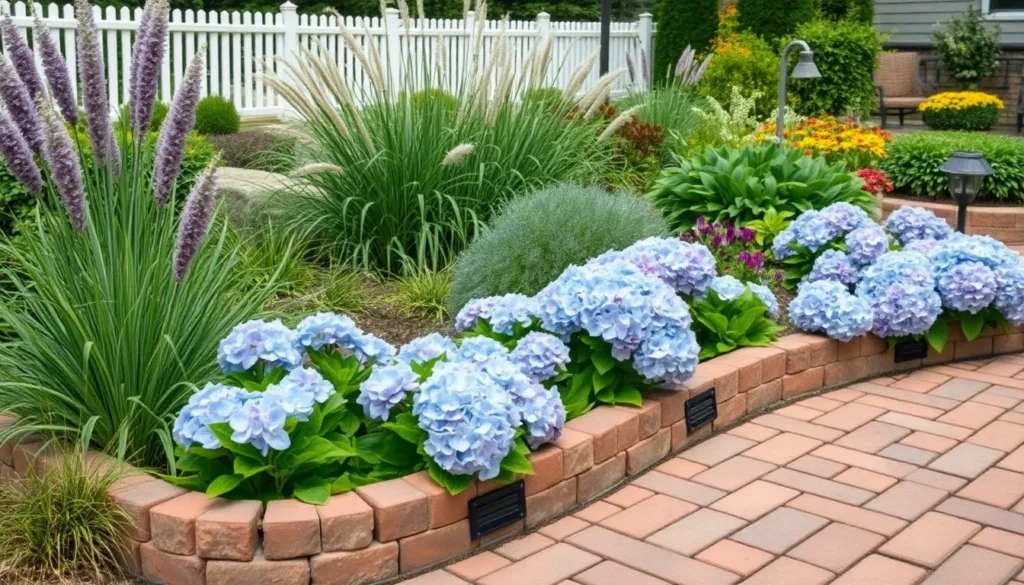














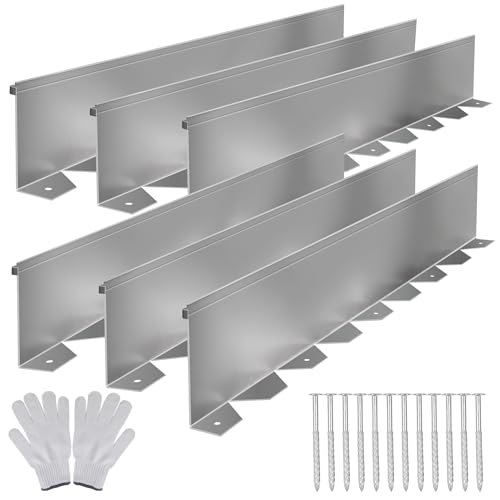



![Landscape Edging 33ft,Garden Edging Borders[Extra Tall 4IN ] Flexible Lawn](https://m.media-amazon.com/images/I/41r+lSjZd3L._SL500_.jpg)

